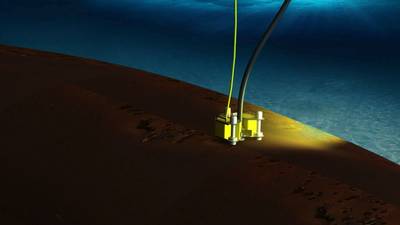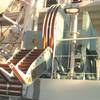New Tool for Recovering Oil from Sunken Wrecks
A tool for removing oil trapped in submerged vessels has been developed in Norway by design specialists Miko Marine.
The launch of the Moskito aims to address the pollution threat that exists with the large numbers of sunken ships around the world that still contain quantities of oil in their tanks as cargo or bunker fuel. Many of the thousands of ships sunk during World War II now have 70 years of corrosion eating at their plates and the days are drawing inexorably closer when the pollutants that they contain will escape. The only answers are to either seal the wreck at great expense or to recover the pollutant in a controlled manner.
The Moskito makes this possible through being able to be deployed by divers or by an ROV (Remotely Operated Vehicle) to any ocean depth. Once in position outside the tank the Moskito’s three powerful magnetic feet are planted against the steel hull and a technician on the surface then activates a 75 mm (3-inch) diameter electrically powered tank cutter drill. With its operation controlled through a dual video link, the Moskito’s drill pierces the steel tank walls which may be up to 40 mm (1.5-inches) thick. The cut disc then falls away inside and is immediately followed into the tank by a patented spring latch coupling that automatically connects and locks a hose to the tank without allowing any of its contents to escape. With the hose securely in position a subsea pump can be activated to extract the oil at the rate of up to 12 cubic meters per hour and send it to the surface for safe and non-polluting recovery. If it becomes necessary to relocate the Moskito it can be easily repositioned without being returned to the surface. Being such a compact device it is also easy to use multiple units close together if a higher rate of extraction is required.
The Moskito arose from a research and development project launched by Miko Marine in 2012. It quickly attracted the interest of the Norwegian Coastal Administration (NCA) which had been grappling with the same pollution problem being caused by spontaneous leaks from sunken wrecks around Norway’s coastline. Having no answer to the problem the NCA decided to support Miko Marine’s quest to find a solution and the two organizations joined forces with the backing of Innovation Norway, a government-sponsored research and development organization.
It was through a combination of engineering skill and original thought that Miko was able to create the Moskito oil removal system. The name of the tool was the inevitable consequence of its working similarity to the unpopular insect. Just like the insect it has to be light, versatile and adaptable because when a ship settles on the seabed there is no knowing how its tanks will come to rest. However, with a visual inspection and by studying the plans of the vessel a means of attack can be found. The Moskito is then delivered to the outside of the tank where it penetrates its skin and inserts its proboscis so that the liquid inside can sucked out. The insect allusion falls short of the engineering reality but the principle is the same and measuring just 65 cm (25-inches) by 45 cm (17-inches) and weighing only 80 kg, by subsea engineering standards the tool has an insect’s light touch.
Commenting on the potential of the Moskito, Nicolai Michelsen, general manager of Miko Marine was pleased to sumarize the success of his company’s innovation. “This was not an easy product to develop as it required us to call upon our highest standards of engineering and design. We are, however, very pleased with the end result which has a practical versatility that will make a valuable contribution to marine environmental conservation. It provides a solution to a problem that has remained unanswered since the first ship sank and we are now hoping that our coastlines and our wildlife will see the benefit.”
Even before developing the Moskito system Miko had enjoyed a close working relationship with the NCA which had become a customer for some of the company’s other innovative products. A team of highly qualified young designers has repeatedly found solutions to thorny problems by lateral thinking and innovation that is not tied to any particular technology. These include a range of magnetic patches that can be used to quickly seal a hole torn in a ship’s hull while the more recent invention of the ShipArrestor has solved the problem of drifting ships by devising a parachute-shaped sea anchor that can be delivered by a helicopter. Instead of rolling helplessly until it breaks up or runs aground, a ship without engine power, or crew to operate it, can now be intercepted by the ShipArrestor and its drift slowed until a tug is able to reach it and tow it to safety.














